
Things we like
- Fantastic e-diff
- Fun loving personality
- Duality of character
Not so much
- Interior materials need improving
- Road noise can be intrusive at highway speeds
- Fighting with siblings for attention
What do you do with a problem like the performance SUV? It is a conundrum that motoring enthusiasts and manufacturers alike need to grapple. For enthusiasts, they are perceived as an unfortunate but necessary evil – an inherently compromised product that needs to be made and sold so that manufacturers can build the low-margin cars we all love. For car companies, the genre can at first seem like a licence to print money. But get it wrong, and you’ll squander all that consumer good-will for nothing.
This is compounded by the fact that through its very nature a performance SUV falls afoul of the unbending laws of physics. Writers love to proclaim that a vehicle defies physics – hell, even I’ve been guilty of this transgression – but idioms aside the fact is you can’t cheat reality. A car with a higher centre of gravity is dealing with an inherit, undeniable disadvantage of reality. So, how do you solve the problem?
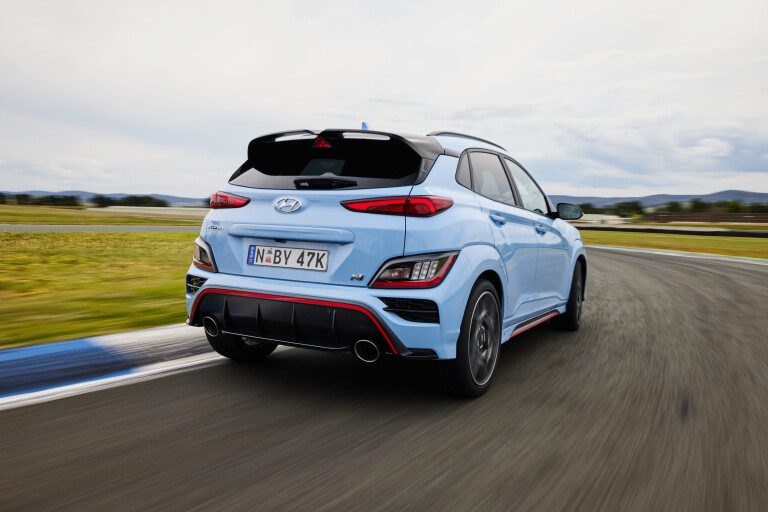
If you are Hyundai, you lean into that fact, which it has done so impressively with its first performance SUV, the Kona N. The basics of the Kona N will be familiar, even if this is an all-new model. Using the chassis of the Kona SUV, it is fitted with the 2.0-litre turbocharged four-cylinder from the i30 N, sending 206kW and 392Nm to the front wheels exclusively via an eight-speed dual-clutch automatic transmission.
Compared to the N-Line, the full-fat N is 10mm lower to the ground. It has a 20mm wider front track and 7mm wider rear track thanks to changes in the suspension geometry, namely redesigned steering knuckles. The Kona N also receives additional reinforcement to the chassis, with extra welds on the A-, B-, and C-pillars for improved body stiffness, with additional structures also added to the chassis tunnel and strut tops.

Instead of focusing on trying to work around the baked-in compromises of being an SUV, Hyundai has used it to its advantage to create something that is more fun than fast. That said, this is still a quick vehicle, with a claimed 0-100km/h time of 5.5 seconds using launch control.
Rather than seeing the longer suspension travel of the SUV as a disadvantage, Hyundai’s ride and handling engineers have used the additional stroke and adaptive dampers to widen the ability bandwidth of the Kona N. In its comfort settings it plays the part of a small SUV commuter with ease. While firmer than a standard Kona, the N is perfectly acceptable for day-to-day duties. Stiffen up the suspension though and the talent in the engineering pool shines through. While spring rates have increased front and rear overall compared to its N-Line variant, the boffins were able to tune the Kona N’s Electronically Controlled Suspension (ECS) to have a softer initial moment of travel before increasing exponentially as the wheel begins to move further. Essentially this allows the Kona N to have the composure of the i30 N during aggressive driving, without skipping and juddering over bumps.
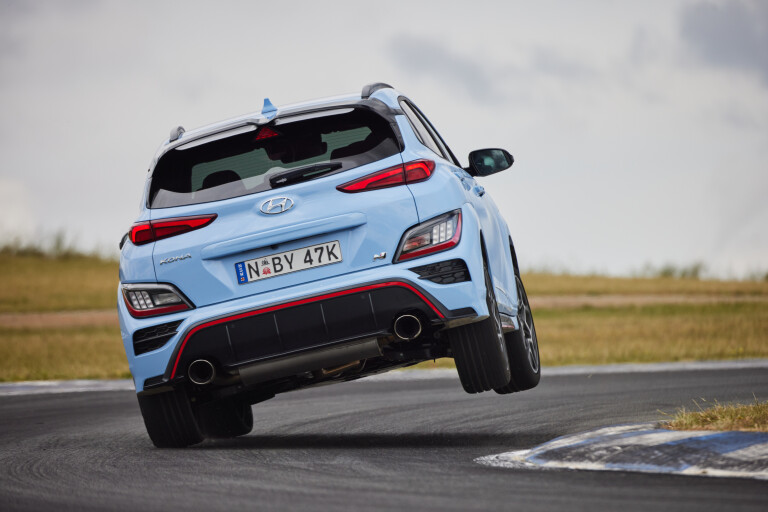
Adaptive dampers help emphasise the Kona N’s split personality. Leave everything in comfort and its an amenable daily driver where the eight-speed auto slips between ratios subtly, the exhaust doesn’t crackle and pop with abandon, and the suspension soaks up the speed bumps and potholes we have become used to in urban settings. For dynamic driving the middle of the three suspension settings is the sweet spot.
This isn’t a wilting flower either, during the launch event the Kona N was put to the test on an extensive road loop, before spending an entire day being punished on track at Wakefield Park. Perhaps the most impressive part of the whole two-day campaign was the brakes, which were well and truly up to the task of extended hard driving. Weighing in at 1510kg, the Kona still has plenty of heft, but it puts on pace with ease. The 360mm vented rotors up front (55mm larger than the standard Kona) and 314mm vented items at the rear scrub off speed impressively. There is a good feel to the pedal, which isn’t artificially over-servo’d, and provides nice feedback on heavy applications. Extra air is dumped onto the brakes via cooling ducts mounted on the lower control arms to help keep temperatures in check.
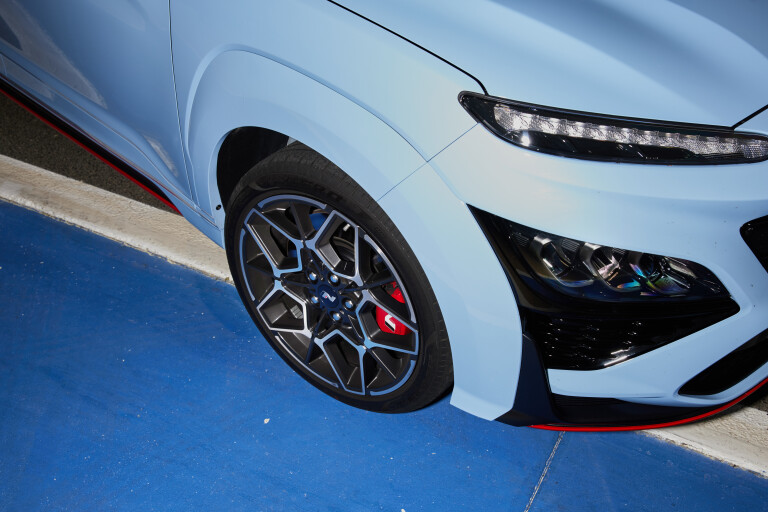
Other than the ride height and track, the Kona N shares the same dimensions as its more pedestrian variants, meaning it has a 50mm shorter wheelbase than the i30 N hatch. It uses this to its advantage, rotating eagerly throughout the cornering process on track, and darting sharply on tip-in on road. You are kept well-informed of proceedings via the rack-mounted motor-driven power steering system which provides fantastic feedback. While perhaps ever so slightly lighter than we would like, you can’t accuse the Kona N’s steering of being numb. The rack is direct and accurate, with a quick 2.2 turns lock-to-lock.
The powertrain of the Kona N doesn’t break any new ground compared to the i30 N, and that’s a good thing. You still get a fat peak torque band that sends all 392Nm to the 235/40 R19 Pirelli P Zero tyres (which are great on track, but loud on road) between 2100-4700rpm. It revs hard, and if the 206kW peak figure doesn’t entirely float your boat, 213kW becomes available for 20 seconds using the cringely named N Grin Shift button on the steering wheel. Think of it as a push-to-pass, which primes the entire drivetrain into maximum attack for 20 seconds. You get the same theatrical exhaust pops and bangs as the i30, and the two customisable N mode buttons on the steering wheel mean your favourite settings are never more than a flick of the thumb away.
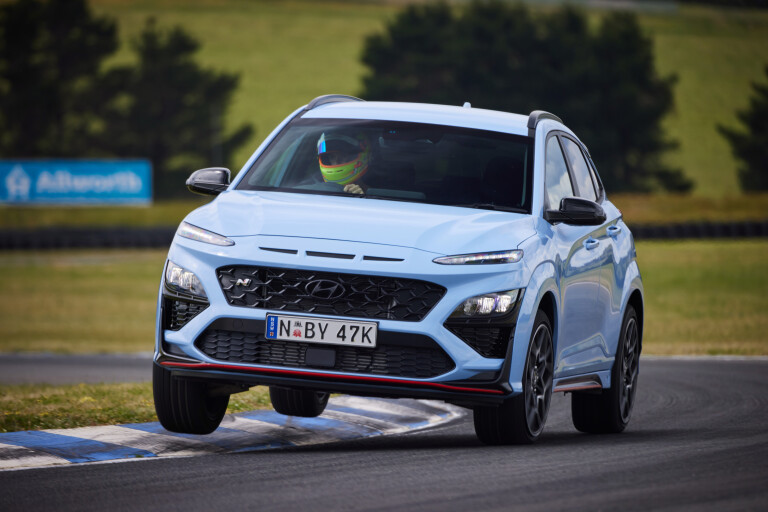
A highlight of the entire package is the electronically controlled, mechanical limited-slip differential. It is the jewel in the crown that is the Kona N’s front-end. The diff is competent at putting power to the ground on corner exit, and we only encountered torque steer on the roughest of road surfaces. Such is the ability of the e-diff that you can begin applying throttle much earlier in the corner than you might first expect, and your foot will be pressed against the firewall long before all four wheels are pointed in a straight line.
The eight-speed dual-clutch is impressively smooth in Normal mode and intuitive in Sport. You can take control of shifts in Manual mode using the paddle shifters, but the ’box is clever enough that you can leave it to its own devises.
The stability control has three stages – Normal, Sport, and off. Be sensible and keep it in Normal for road use, but if you take the Kona N to the track make sure to switch things to Sport. This allows the vehicle to let its rascal personality fly free, offering you plenty of lateral movement without any electronic intervention.

Along with all the performance, you still get SUV practicalities. The higher ride height means you won’t be stressed about bottoming the front lip on nasty driveways, the boot is on-par with the small SUV norm at 361 litres. However, the rear seats are a touch small for taller adults.
The entry-level Kona N costs $47,500 plus on-roads. Don’t think Hyundai have skimped on the equipment. While you get cloth seats instead of the more expensive Premium’s suede and leather combo trim, we preferred the base model’s units, while the steering wheel, handbrake lever (yes, you get an honest larrikin-spec manual handbrake), and gear selector are all wrapped in cow hide. The full SmartSense safety suite is standard on each N variant, along with the dual 10.25-inch LCD infotainment and instrument screens. LED lighting, push-button start, rain sensing wipers and climate control also feature free of extra cost.

Stepping up to the $50,500 Kona N Premium adds the aforementioned seats which are heated, ventilated and power adjustable for front occupants, a head-up display, heated steering wheel, front parking sensors, sunroof, ambient lighting and an electrochromic rear view mirror. One of our biggest criticisms of the Kona is that even in the Premium, the cabin is heavily proliferated with scratchy hard plastics which might turn off buyers wanting something a bit more, well, premium.
It’s a small concern though, particularly when you get back to the actual act of driving the Kona N. In almost every setting it is an endearing and charming thing. Hyundai’s N division has, once again, nailed the brief. A short-sighted or ill-informed assessment of the Kona N might simply state that it is a performance SUV ergo it must be less fun to drive than its hatch sibling. Not so. If we were to pick a car from the N line-up to drive not for outright speed, but laughs, it’d be the Kona N. The fact that there is an i20 N, i30 N hatch, and soon i30 N sedan in the Hyundai performance family, means the Kona is free to play in a realm where enjoyment, not outright speed, is king.
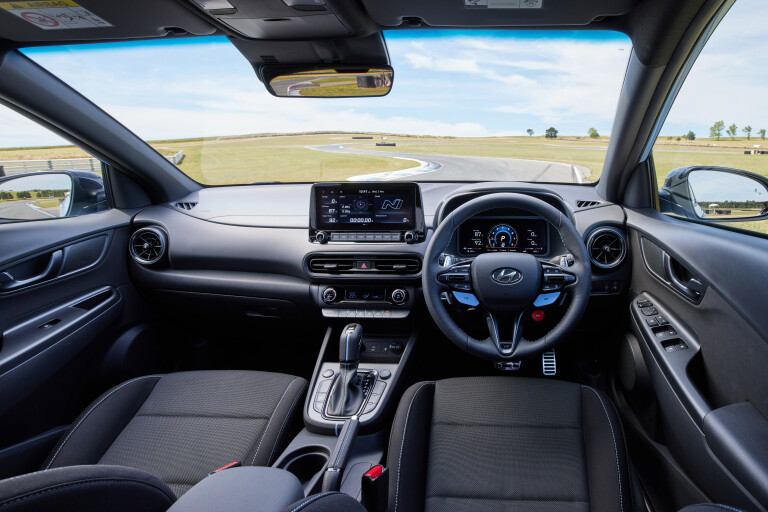
You can take a Kona N to a track and lay down an impressive lap time. In fact, the reduced wheelbase means that on certain tight and twisting circuits it may very well be on par or quicker than its i30 N hatch sibling. But you don’t buy the Kona N to build a track weapon; you buy it because you want to have fun. Great big lift-off oversteer, cock a rear wheel, can’t wipe the smile off your face fun.
Before you sneer at its SUV proportions, give the Kona N a chance. It’ll be worth your time.

2022 Hyundai Kona N specifications
| Body: | 5-door, 5-seat SUV |
|---|---|
| Drive: | front-wheel drive |
| Engine: | 1998cc inline-4, DOHC, 16V, turbo |
| Bore x Stroke: | 86 x 86mm |
| Compression: | 9.5:1 |
| Power: | 206kW @ 5500rpm |
| Torque: | 392Nm @ 2100-4700rpm |
| Power/Weight: | 136kW / tonne |
| Transmission: | 8-speed dual-clutch |
| Weight: | 1510kg |
| Suspension: | MacPherson struts, coil springs, adaptive dampers (f), multi-links, coil springs, adaptive dampers (r) |
| L/W/H: | 4215/1800/1565mm |
| Wheelbase: | 2600mm |
| Tracks: | 1579mm front, 1575mm rear |
| Steering: | electrically assisted rack-and-pinion |
| Brakes: | Dual-Diagonal, Split-Circuit, Power Assisted + EBD. Ventilated discs – 360mm front, 314mm rear |
| Wheels: | 19.0 x 8.0-inch (front/rear) |
| Tyres: | 235/40 R19 (front/rear), Pirelli P Zero |
| Price: | $47,500 |
Things we like
- Fantastic e-diff
- Fun loving personality
- Duality of character
Not so much
- Interior materials need improving
- Road noise can be intrusive at highway speeds
- Fighting with siblings for attention



COMMENTS